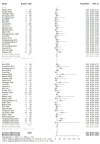Radiation-Induced Retinopathy and Optic Neuropathy after Radiation Therapy for Brain, Head, and Neck Tumors: A Systematic Review
- PMID: 37046660
- PMCID: PMC10093581
- DOI: 10.3390/cancers15071999
Radiation-Induced Retinopathy and Optic Neuropathy after Radiation Therapy for Brain, Head, and Neck Tumors: A Systematic Review
Abstract
Background: Patients with brain, head, and neck tumors experience a decline in their quality of life due to radiation retinopathy and optic neuropathy. Little is known about the dose-response relationship and patient characteristics. We aimed to systematically review the prevalence of radiation retinopathy and optic neuropathy.
Method: The primary outcome was the pooled prevalence of radiation retinopathy and optic neuropathy. The secondary outcome included the effect of the total radiation dose prescribed for the tumor according to the patient's characteristics. Furthermore, we aimed to evaluate the radiation dose parameters for organs at risk of radiation retinopathy and optic neuropathy.
Results: The pooled prevalence was 3.8%. No retinopathy was reported for the tumor's prescribed dose of <50 Gy. Optic neuropathy was more prevalent for a prescribed dose of >50 Gy than <50 Gy. We observed a higher prevalence rate for retinopathy (6.0%) than optic neuropathy (2.0%). Insufficient data on the dose for organs at risk were reported.
Conclusion: The prevalence of radiation retinopathy was higher compared to optic neuropathy. This review emphasizes the need for future studies considering retinopathy and optic neuropathy as primary objective parameters.
Keywords: brain tumors; head and neck tumors; radiation optic neuropathy; radiation retinopathy; radiation therapy.
Conflict of interest statement
Tanja Alderliesten is involved in projects supported by Elekta AB, Stockholm, Sweden. Buket Kinaci-Tas, Frank Verbraak, and Coen R.N. Rasch declare no conflict of interest.
Figures






References
Publication types
Grants and funding
LinkOut - more resources
Full Text Sources

